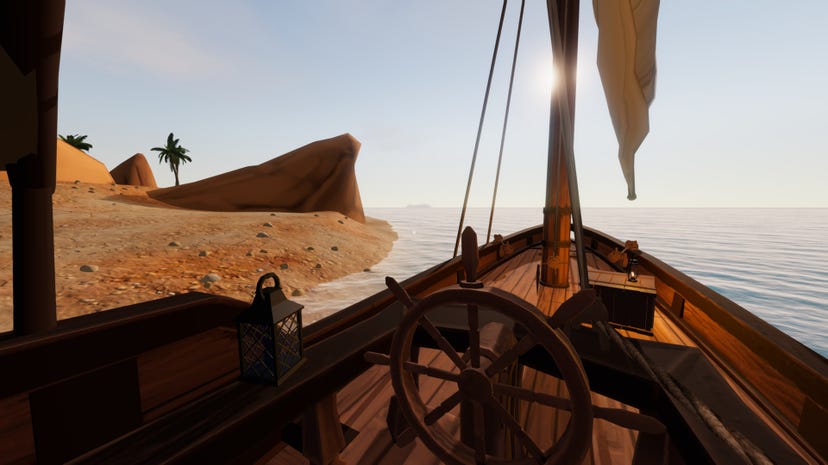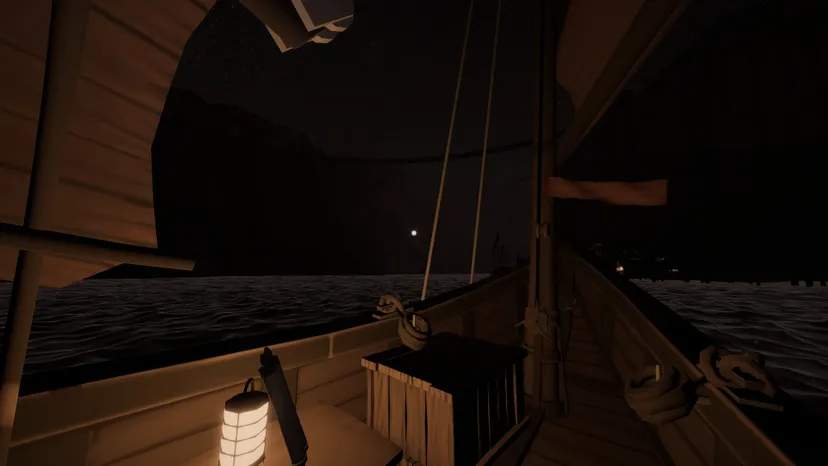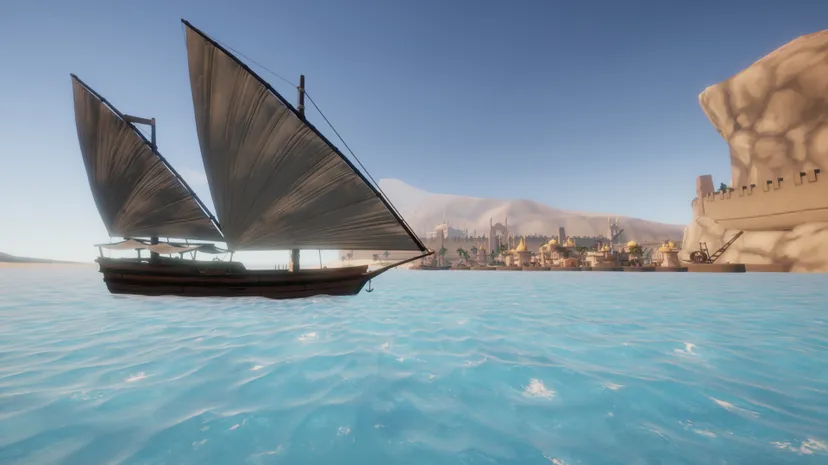
Sailwind
is a physics-based sailing simulator, largely made by one person. Your
character is onboard a boat, and operates it by pulling ropes and
spinning the wheel. There is a map (in your inventory), but it doesn’t
tell your exact location. Instead you have to use other means to
discover where you are and where you’re headed, and it’s up to you to
figure out how to get to your destination.
Sailing isn't only about controlling a ship on the the open seas,
however. Along the way, you are faced with survival and trading elements
that help to create emergent tales of exploration and adventure. Of
course, opposed to those meager trading efforts are the forces of wave
and wind, storm and starvation as meaningful accomplishment can't truly
be felt without a little risk thrown into the mix.
Coming from a background of VR development and immersive experiences, developer Raw Lion Workshop calls Sailwind
their most ambitious project to-date. The dev explores that complexity
in this chat with Game Developer, digging into what brought about this
open-world sailing simulator, its realistic sailing physics, and the
elements of survival, trading, and adventure that define this journey
across the sea.
Game Developer: Sailwind is a full 3D sailing simulation made primarily by one person! How long have you been going, and what technology do you use to put it together? How do you handle creating the game's content?
Raw Lion Workshop: It's been close to three years since I started the project, though only the last two years were full time work. The game is made in Unity, using the Crest ocean asset for rendering the ocean and basic boat physics. Most of the other features I have developed on my own. The models and textures are made in Blender, and for sound effects I use creative commons and public domain sounds available online, often heavily edited to fit into the game.
All games that simulate some real-world activity must do so through some degree of representation, but Sailwind does a good job of exposing players to the details of how sailing works. Most nautical-themed games take a more game-ish approach to this subject, while Sailwind almost seems like it wants to teach players how to actually sail a boat. What caused you to think about going in this direction with the development, focusing on the kinds of details that triple-A games would strive to eliminate?
The project started as a simple prototype - I was just having some fun playing with a realistic sailing physics model. At this stage, I didn't really consider any game design or player experience aspects. As I played with my prototype, I realized that it was actually quite fun and satisfying to handle the sail, watch how it reacts to the wind and how it affects the boat and its movement, and that's when I decided to build a full game around it.

It was only after the game was released that I discovered how challenging this realistic sailing model was for many players. To be honest, it was quite a big surprise to find out just how much people struggled with it. After all, I thought, sailing really isn't that complicated, compared to, say, flying a plane in a flight simulator. If anything, I was worried the game would be too simple, and I was considering adding more complexity to the controls to make it more interesting and engaging. After many complaints about the steep learning curve (and a relatively high refund rate), I understood why the triple-A game studios often have to simplify their games so much. Big studios have to appeal to the widest possible audience in order to make a good return on their investment, and that means the barrier to entry for new players has to be as low as possible and the learning curve very forgiving. Unfortunately, such design generally makes the game less appealing for those who are looking for a deeper and more challenging experience.
I'm still trying to find the happy medium between making the game approachable and pleasant for new players with no sailing experience, and keeping the complexity, realism, and integrity. There is certainly a lot of satisfaction to be had when you master the techniques of sailing and navigation, and the learning and struggles can add to the experience and make it more meaningful. Games that hold your hand, give you lots of hints at every step, and pretty much play themselves don't provide that same sense of accomplishment and satisfaction. However, if faced with too much challenge at the start, many players will just quit in frustration.
Sailing is complicated. How does Sailwind go about helping players get their feet wet, so to speak, in learning to operate a boat?
Currently, the tutorial is quite basic - there's a scroll on your boat which contains text and pictures describing the basics of gameplay and sailing.
Improving the tutorial is definitely something I'm working on. It's all about finding the balance between smoothing out the learning curve to avoid the initial frustration, while still challenging the player to figure things out and learn by themselves. I've recently added a new tutorial feature which visually shows you the no go zone when trying to sail upwind, which is a very important concept when learning to sail. This new addition was controversial in the community for a good reason - features like this can diminish the sense of accomplishment and make the game feel too cheap and easy, so I am very cautious not to move too far in that direction.
Actually operating and manipulating a boat is just part of sailing of course. Some other games find it challenging to enable the player to find his position and get oriented in the world, even with the use of UI aids, but Sailwind don't use those on purpose! The possibility of getting lost, as in real life, is another part of the game. How does a player handle navigation, getting bearings and figuring out the best direction to head in?
Getting lost is fun! That's often when the real adventure starts, and it's a great opportunity for emergent challenges and organic stories to develop. Also, in a game with no enemies or combat of any kind, the possibility of getting lost adds an element of risk and challenge. The risk of failure is what makes success meaningful, and it's one of the necessary elements of any game.
In Sailwind, there are many ways to navigate, and you'll have to choose between them depending on your current situation. There is of course the compass, but if you accidentally drop it overboard (which does happen to many players, apparently!), you can also use the sun, or even the stars in the night sky, to find the cardinal directions.
There is also the quadrant (a simpler version of the sextant), which you can use to determine your latitude, and the chronocompass, a rather complicated tool which uses the sun and its shadow to find the latitude and longitude. More instruments will be added later on. Skilled use of these instruments is necessary in order to successfully complete long ocean voyages (which can take many hours in real time!).
It's easy to focus just on the sailing and neglect talking about the non-sailing aspects of the game. There's survival elements, and a basic trade simulation where the player takes on delivery jobs, and attempts to complete them for money while keeping his reputation up. How much of the game do these aspects make up? Are you considering deeping these elements of play, like, are there plans in the offing to require that players carry limes to prevent scurvy?
I actually don't consider those features as separate from the sailing aspect. For me, sailing is more than just controlling a boat. When I think of sailing, I think of adventure, travel, exploration. I think of brave men confronting the forces of nature on an epic journey towards the unknown. Without these aspects, sailing is reduced to just pulling ropes, turning the wheel, and steering the boat towards no particular goal. Those things aren't all that fun by themselves, it's exactly that context of the epic adventure that makes sailing so appealing.
The survival and trading elements in Sailwind serve that goal, they are there because without them the sailing wouldn't be "real" in some sense. The need to stock up on food and other supplies adds an element of risk and strategy, the trading and delivery missions mean you have a destination, a goal which is a part of a bigger story.
In Sailwind, you're not just sitting there watching your boat move through the water - you're on an epic voyage across a vast ocean, battling storms and overcoming challenges to deliver vital goods to people living in distant settlements. That's what sailing is really about!
This is also one of the main areas I want to develop further. Expanding the trading system is a high priority item on the roadmap at the moment, and there are also plans to expand food and drink systems, such as introducing the need for balanced nutrition and adding food spoilage.

One of the interesting design decisions you're made is to enforce the need to sleep. It's amazing really how many games handwave sleep away. A one-person vessel on the ocean has unique strategic requirements. The boat doesn't stay still while the player's character is unconscious, but continues to travel. What would you say this brings to the game?
As with most features of Sailwind, I didn't consciously think about the game design implications of the sleep system. It is simply something that just... made sense. After all, that's how sleeping works in the real world! As it turned out, it fits in the game quite well, but this is more of a happy accident than a planned decision.
First, it adds another layer to the challenge and decision making aspects, which is pretty important in a relatively simple game like Sailwind. Second, it gives players an opportunity to take a short break, maybe stretch a bit, shift their attention away from the game for a moment, which is probably a healthy thing to do in a long gaming session.
A concession it seems Sailwind must make to physical reality is the nature of the time scale compared to player's life. 24 game hours cannot equal 24 real hours if the game is to progress at a reasonable rate. How does Sailwind handle this? Does it make day lengths shorter, distances shorter, or speeds greater than in real life?
Sailwind takes place on a planet which is significantly smaller than Earth, and the distances and time are scaled down accordingly, but I've tried to keep this scaling somewhat consistent. That is, sailing around the globe in the game (not possible currently, by the way) might take a similar amount of days as it would in the real world on Earth.
The boats are generally slightly faster than they would be in real life, but not nearly as much as in most other sailing games. This slightly faster speed is purely a game design decision - realism is good and all, but going very slow can often feel frustrating and just not very fun.
Sailwind is a fascinating game even at this early stage. Part of what I find personally exciting about it is, it feels like a simulation of an ancient real-world activity that used to inspire a whole genre of literature. Sandbox games are kind of like a self-told storytelling device, a way to have imaginary adventures that can actually be affected by the player's actions, and Sailwind's concept is unusually powerful here. But that's just me; why did you decide to make this, what is it about the idea that pushes you to work on Sailwind every day?
I think the biggest advantage video games have over other media is precisely this potential to create dynamic and unique stories. These stories can be important and meaningful, they're more than just "fun". For me, it's these stories that can make playing a game a worthwhile experience, and that's why these are the types of games I'm interested in. I'm not really into games that try to capture your attention with highly engaging visuals, instant gratification or cheap rewards. That type of entertainment feels good in the moment, and can be highly addictive, but it leaves you drained, tired, and often feeling like you've just wasted your time doing nothing productive.
On the other hand, when you create and experience a meaningful story during your gaming session, it feels fulfilling - the time is not wasted, it was well spent. That's always my goal when making games. To provide more than just entertainment. I want the player to feel like they've spent their time well, and experienced something meaningful.
